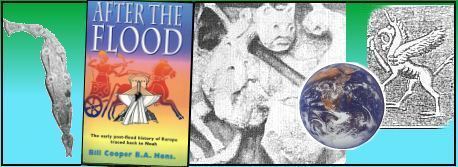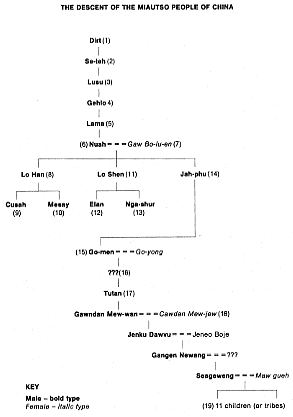
After the Flood - by Bill Cooper |
CHAPTER
I
CHAPTER II CHAPTER III CHAPTER IV CHAPTER V CHAPTER VI CHAPTER VII CHAPTER VIII CHAPTER IX CHAPTER X CHAPTER XI CHAPTER XII CHAPTER XIII |

After the Flood - by Bill Cooper |
CHAPTER
I
CHAPTER II CHAPTER III CHAPTER IV CHAPTER V CHAPTER VI CHAPTER VII CHAPTER VIII CHAPTER IX CHAPTER X CHAPTER XI CHAPTER XII CHAPTER XIII |
| << PREV |
Europe traced back to Noah" |
I have constructed the following patriarchal genealogy from the
translation by Edgar Truax (1) of the oral
traditions of the Miautso people of China. They were yet another early
people who regarded themselves as being descended from Japheth, and who
remembered some of the other early patriarchs whose names likewise appear
in the Genesis record. They were found to already possess this knowledge
in the form of ancient couplets when they were encountered for the first
time by Christian missionaries. Moreover, they were in possession of surprisingly
accurate recollections of the Creation and the Flood, and some of the close
detail of their accounts coincides almost identically with the Genesis
record. Having originally settled in what is now the Kiangsi province of
China, from where they were later driven out by the Chinese, they claim
that they are not themselves of Chinese stock, and this is borne out by
their insistence that they are descended from Japheth, i.e. of Indo-European
descent. The oral traditions in which the descent of the Miautso has been
preserved, owe their purity to the fact that they have been recited faithfully
and in fill at funerals, weddings and other public occasions since time
immemorial.
Notes on the Descent of the Miautso People of China2. Se-teh: The Biblical Seth. 3. Lusu: The names in the book of the Generations of Adam (Genesis 5) that immediately follow that of Seth are: Enos, Cainan, Mahalaleel, Jared, Enoch and Methuselah. The name Lusu may conceivably be identified as a corruption of one of the elements of Mahalaleel. Otherwise, it is unidentifiable. 4. Gehlo: A corruption, perhaps, of the final element of Methuselah's name. Otherwise, it is unidentifiable. 5. Lama: The Biblical Lamech. 6. Nuah: Noah. In the Miautso account, Nuah was a righteous man who was commanded by God to build a great ark. The release of the dove from the ark is mentioned amidst a graphic and somewhat horrifying depiction of the Flood itself and the eventual drying out of the land. |
 |
7. Gaw Bo-lu-en: Apart from certain Jewish traditions, this is an interesting and rare naming of Noah's wife. Genesis, of course, does not give her name.
8. Lo Han: The Biblical Ham. The descent of the following identifiable patriarchs is given along with a graphic account of Babel and the confusion of tongues. It is then told how the nations spread out from Babel and encircled the globe. This is a surprising preservation of ancient knowledge, for the Miautso, at the time of their first encounter with missionaries, had no concept of the earth being round.
9. Cusah: The Biblical Cush.
10. Mesay: The Biblical Mizraim.
11. Lo Shen: The Biblical Shem.
12. Elan: The Biblical Elam.
13. Nga-shur: The Biblical Asshur.
14. Jah-jbku: The Biblical Japheth.
15. Go-men: The Biblical Gomer.
16. ???: An unnamed patriarch.
17. Tutan: This was an adopted name.
18. The following list of patriarchs and matriarchs indicate the seriousness with which the Miautso kept their pedigrees in common with many other early peoples.
19. According to the Miautso themselves, of these eleven children or tribes, five formed the Miautso nation, and six intermarried with the invading Chinese.
Note
1. Truax, E. Genesis According to the Miao People. Impact Article.
April 1991. Institute for Creation Research, P0 Box 2667, El Cajon, California
92021 USA.
| << PREV |
|
|